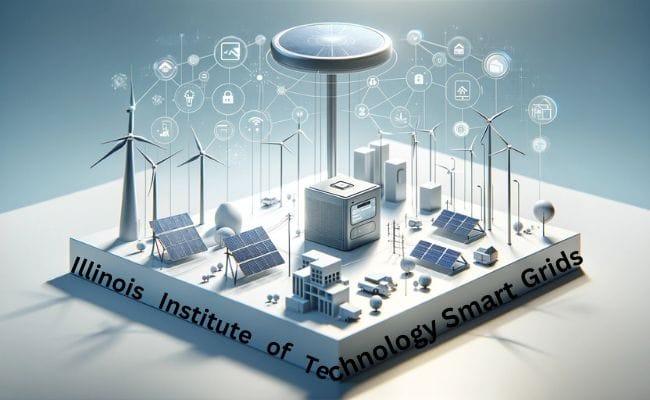
Illinois Institute of Technology Smart Grids
Imagine a world where energy flows seamlessly and power outages are a thing of the past. Welcome to the future of electrical infrastructure: smart grids. This revolutionary technology enhances efficiency and empowers communities through better resource management and sustainability. At the forefront of this transformation is the Illinois Institute of Technology Smart Grids, which leverages smart grid innovations for educational purposes and practical applications.
In this blog post, we’ll explore what makes smart grids so essential in today’s rapidly evolving energy landscape, delve into IIT’s groundbreaking projects, and highlight their achievements along the way. Whether you’re an energy enthusiast or simply curious about modern technology at work, you’re in for an enlightening read!
What is a Smart Grid?
A smart grid is an advanced electrical system that integrates digital technology with traditional energy infrastructure. It enhances the efficiency and reliability of electricity distribution by enabling two-way communication between utilities and consumers.
This innovation allows for real-time monitoring of power usage, making it easier to manage demand and supply. Smart grids utilize sensors, smart meters, and automated controls to optimize energy flow.
The result? Fewer outages, improved response times during emergencies, and lower operational costs for utility companies.
Additionally, they support renewable energy sources like solar panels and wind turbines by balancing intermittent power generation. With a focus on sustainability, smart grids are paving the way toward a greener future while empowering consumers to take control of their energy consumption.
The Benefits of Implementing Smart Grid Technology
Implementing smart grid technology brings transformative benefits to energy systems. It enhances efficiency, allowing for real-time monitoring and management of electricity usage. This reduces waste and optimizes power distribution.
Smart grids empower consumers with data-driven insights into their energy consumption patterns. With this information, households can adjust their usage habits, leading to significant cost savings on utility bills.
Smart grids also make it easier to integrate renewable energy sources like wind and solar. They create a more resilient infrastructure capable of adapting to fluctuating supply conditions.
Environmental impacts are also noteworthy. By promoting cleaner energy use and reducing emissions associated with traditional power generation methods, smart grids contribute positively to sustainability goals.
Enhanced reliability is another key advantage; outages become less frequent due to advanced sensors that detect faults before they escalate into widespread failures. These benefits collectively shape a smarter future for all stakeholders involved in the energy landscape.
Case Study: Illinois Institute of Technology’s Smart Grid Project
The Illinois Institute of Technology (IIT) is at the forefront of smart grid innovation. Their ambitious project aims to integrate advanced technologies into their existing energy infrastructure.
By leveraging real-time data and analytics, IIT enhances energy efficiency across campus facilities. This initiative not only reduces operational costs but also minimizes environmental impact.
IIT’s collaboration with industry partners and government agencies accelerates research and development in this field. The project’s design includes a sophisticated monitoring system that tracks electricity consumption patterns.
Students play an active role, gaining hands-on experience with cutting-edge technology. They contribute fresh ideas while learning about sustainable practices.
This case study highlights IIT’s commitment to creating a resilient energy future through smart grid technology, setting an example for other institutions aiming for sustainability in their operations.
How the Smart Grid Works at IIT

The Smart Grid at the Illinois Institute of Technology integrates advanced technology with energy management. It employs sensors, digital meters, and automated systems to monitor real-time data on electricity usage.
This setup allows for enhanced communication between utilities and consumers. Users receive instant updates about their energy consumption patterns, helping them make informed decisions.
Renewable energy sources are also part of this grid. Solar panels installed on campus feed power back into the system, promoting sustainability.
Data analytics play a crucial role in optimizing performance. By analyzing usage trends, IIT can predict demand fluctuations and adjust its resources accordingly.
Moreover, smart technologies enhance reliability. If an outage occurs, automatic rerouting mechanisms quickly restore power to affected areas without manual intervention.
Students and faculty engage with these technologies through research projects that explore innovative solutions for modern energy challenges.
Successes and Challenges Faced by IIT in Implementing the Smart Grid
The Illinois Institute of Technology (IIT) has achieved significant milestones in its smart grid implementation. One notable success is the integration of renewable energy sources, which promotes sustainability on campus. This transition not only enhances energy efficiency but also serves as a practical model for students studying environmental engineering.
However, challenges accompany these advancements. The initial investment and ongoing maintenance costs can be daunting. Securing funding while balancing educational priorities requires strategic planning and collaboration among stakeholders.
Additionally, integrating advanced technologies may encounter resistance from some community members who are hesitant about change. Education and outreach efforts have become crucial to address these concerns and foster acceptance.
Data security remains another pressing issue. Ensuring that the smart grid’s infrastructure is resistant to cyber threats demands continuous vigilance and innovative solutions from the IIT team.
Future Plans for IIT’s Smart Grid System
Illinois Institute of Technology is committed to advancing its smart grid technology. Plans include enhancing energy management systems for improved efficiency.
The university aims to integrate renewable energy sources more effectively. This will reduce reliance on traditional power grids and promote sustainability.
Additionally, IIT seeks to collaborate with industry leaders on research initiatives. These partnerships can foster innovation in smart grid solutions and create real-world applications.
Plans also encompass expanding educational programs around smart grid technologies. Students will gain hands-on experience, preparing them for careers in this growing field.
Implementing advanced data analytics is another focus area. By leveraging big data, IIT hopes to optimize energy consumption patterns across campus facilities.
The vision for IIT’s smart grid system promises a smarter, greener future while positioning the institution as a leader in energy technology advancements.
Conclusion
The Illinois Institute of Technology stands at the forefront of innovation with its smart grid initiatives. By embracing cutting-edge technology, IIT not only enhances campus energy efficiency but also serves as a model for sustainable practices.
Through continuous research and development, the institution contributes significantly to advancing smart grid solutions. This commitment reflects a broader vision for energy resilience in urban settings.
As challenges arise, the collaborative spirit at IIT fosters creativity and determination. The focus remains on overcoming obstacles while maximizing benefits for both students and faculty.
With ambitious plans on the horizon, IIT aims to refine its smart grid systems further. This journey promises exciting developments that could reshape how educational institutions approach energy management.
Such initiatives highlight the importance of integrating technology into everyday life, paving the way toward smarter cities and communities.
FAQ
Future Plans for IIT’s Smart Grid System
Ans: The future of the Illinois Institute of Technology’s smart grid system looks promising. Plans are in place to enhance energy efficiency across campus and beyond. By integrating advanced technologies, IIT aims to optimize power distribution.
One exciting initiative is the expansion of renewable energy sources. Solar panels and wind turbines may soon become a more significant part of their infrastructure. This shift aligns with global sustainability goals.
Another focus involves improving data analytics capabilities. By harnessing big data, IIT can monitor energy consumption patterns more effectively. This insight will lead to smarter decisions about resource allocation.
Collaboration with industry leaders is also on the agenda. Partnering with tech companies could bring innovative solutions to real-world challenges faced by urban environments.
IIT envisions creating a model for other institutions looking to adopt similar systems. The aim is not just innovation but setting new standards in smart grid technology development.
What is special about the Illinois Institute of Technology?
Ans: The Illinois Institute of Technology (IIT) stands out for its strong focus on innovation and technology. Nestled in Chicago, it combines rigorous academic programs with cutting-edge research opportunities.
One remarkable aspect is the university’s commitment to sustainability. IIT actively integrates green practices into its curriculum and campus operations, making it a leader in eco-friendly initiatives.
Another noteworthy feature is its diverse range of interdisciplinary programs. These foster collaboration between engineering, science, architecture, and business students preparing them for real-world challenges.
Additionally, IIT’s faculty includes industry experts and researchers who bring valuable insights to the classroom. This connection ensures that students receive practical knowledge alongside theoretical foundations.
The vibrant campus culture encourages student involvement through various organizations and events that promote engagement beyond academics. It creates a unique environment where learning extends beyond lecture halls while enhancing social skills and networking opportunities.
What distinguishes a microgrid from a smart grid?
Ans: A smart grid and a microgrid both enhance energy management, but they serve different purposes.
A smart grid refers to an advanced electrical grid that uses digital technology. It integrates various sources of energy, monitors consumption patterns, and improves the efficiency of electricity distribution across large areas. Smart grids enable utilities to better manage supply and demand while providing consumers with real-time data about their energy usage.
On the other hand, a microgrid operates on a smaller scale. It can function independently or in conjunction with the main power grid. Microgrids often incorporate renewable energy sources like solar panels or wind turbines. They provide localized control over energy generation and distribution, making them ideal for communities seeking increased resilience against outages.
In essence, while both systems aim for improved efficiency and reliability in energy delivery, their scope and application differ significantly.
What is the new technology smart grid?
Ans: Smart grid technology represents a transformative leap in how we generate, distribute, and manage electricity. It integrates advanced communication tools with traditional power systems. This synergy allows for real-time monitoring and control of energy flow.
At its core, the smart grid uses digital sensors and automation to improve efficiency. These technologies facilitate two-way communication between utility providers and consumers. Users can then make informed decisions about their energy consumption.
Renewable energy sources such as solar panels and wind turbines are seamlessly integrated into this system. Smart grids foster sustainability by enabling better management of these variable resources.
Energy storage solutions also play a crucial role in smart grids. They help balance supply and demand fluctuations while enhancing reliability. The result is a more resilient electrical infrastructure that adapts to changing conditions dynamically.
Is the Illinois Institute of Technology good or bad?
Ans: The Illinois Institute of Technology has established itself as a leading institution in the field of engineering and technology. Its commitment to integrating innovative solutions like smart grids demonstrates its forward-thinking approach. This initiative not only enhances campus operations but also prepares students for future challenges in energy management.
Students benefit from hands-on experiences that merge theory with practical applications. The research opportunities available at IIT are robust, often leading to significant advancements in sustainable technologies.
Critics may point out that implementing such large-scale projects comes with hurdles, including funding and technological limitations. However, the proactive strategies adopted by IIT showcase their resilience and determination to overcome these obstacles.
Whether one views the Illinois Institute of Technology as good or bad may depend on individual perspectives regarding educational value and innovation capacity. Still, their efforts toward developing smart grid technology position them favorably within academic circles and industry alike.




